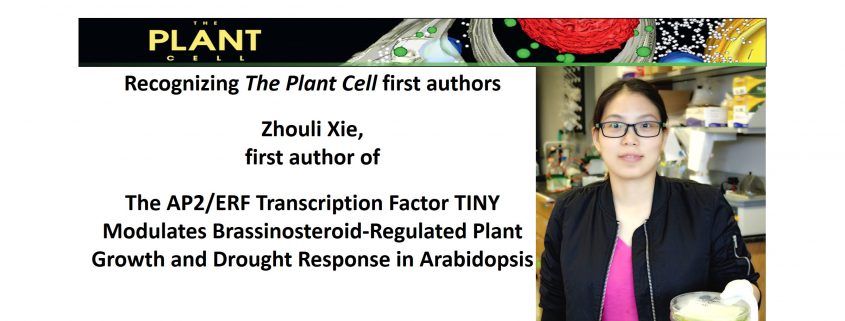Recognizing Plant Cell first authors: Zhouli Xie
Zhouli Xi, first author of The AP2/ERF Transcription Factor TINY Modulates Brassinosteroid-Regulated Plant Growth and Drought Response in Arabidopsis
Current Position: Postdoc in Peking University at School of Life Sciences college.
Education: PH.D. Iowa State University; M.S China Agricultural University; B.S Huazhong Agricultural University
Non-scientific Interests: traveling, cooking, and swimming
Brief bio: My entire research experiences are exploring how to make plant grow better under stress conditions. During M.S. study, I joined Dr. Zhaohu Li’s lab and studied the physiological and molecular mechanisms about how plant regulator DPC induces the dwarf soybean plants. Later, I came to Iowa State University and joined Dr. Yanhai Yin’s lab to focus on studying the function of stress related transcription factors in Brassinosteroid (BR) signaling pathway in Arabidopsis.
The major transcription factors I worked on were TINY and its homologs from AP2/ERF family A4 subgroup. The AP2/ERF family transcription factors (AP2/ERFs) have spurious functions, which in many cases, AP2/ERFs contribute to stress tolerance whereas they inhibit plant growth as well. I found that TINY highjacked the BR signaling pathway (the well-known pathway that promotes Arabidopsis as well as crops growth) during drought stress to positively regulate drought tolerance and negatively regulate plant growth. However, to prevent activation of stress response under optimal growth conditions, the BR pathway promotes TINY degradation by a negative regulator in the BR pathway, the GSK3-like kinase, BIN2. TINY was phosphorylated and stabilized by BIN2 during stress. Besides, TINY interacted with and inhibited BES1, a key positive BR signaling component on the regulation of BR regulated gene expression. Together, to increase stress tolerance while maintaining crop yield are scientists goal for future crops manipulation. Although our work demonstrates how TINY, a positive regulator of stress, inhibits BR-regulated plant growth, the contribution of TINY to drought tolerance and the degradation of TINY under normal growth conditions enable crop scientists to make the usage of this step-wise regulation to overcome growth-stress tradeoffs.
第一作者: 谢周丽
当前职位:北京大学生命科学学院博士后
教育:本科毕业于华中农业大学;硕士毕业于中国农业大学;博士毕业于美国Iowa State University;
兴趣爱好:旅游,美食,游泳
个人简介:我的整个科研生涯都是围绕植物生长与抗逆同行的方向进行的。研究生学习期间,我有幸加入中国农业大学李召虎教授实验室开展缩节胺诱导大豆植株矮化的生理和分子生理研究。在这之后,我来到Iowa State University加入 Yanhai Yin 教授实验室,并开展抗逆相关转录因子在拟南芥油菜素内酯 (BR) 信号转导路径相关功能的研究。 在这期间,我主要从事 AP2/ERF 家族 A4 亚族中 TINY 和其同源基因在生长和抗逆方面的功能研究。AP2/ERF 家族的转录因子有着有趣的生物调节功能:主要表现在促进植株抗逆和抑制植株生长。我的研究发现:在干旱条件下,TINY 入侵 BR信号通路来正调控干旱和负调控生长。但是,在适合植物生长的条件下,植物可以通过BR信号通路中的负调控因子BIN2磷酸激酶来抑制TINY的蛋白积累,从而抑制不必要的干旱响应。在逆境条件下,TINY 可以在 BIN2 激酶的帮助下转化成更加稳定的磷酸化形式。与此同时,TINY 可以和 BR 信号通路中的正调控转录因子 BES1 互作,并且表现出对BR 控制的生长和干旱基因的拮抗功能。 总的来说,提高植物的抗逆性能和产量是科学家一直孜孜不倦追求的目标。尽管我们的研究表明TINY正调控干旱逆境,负调控植物生长,但是 TINY 对干旱有利的一面和被BR信号通路控制机制仍然值得科学家们的借鉴。




